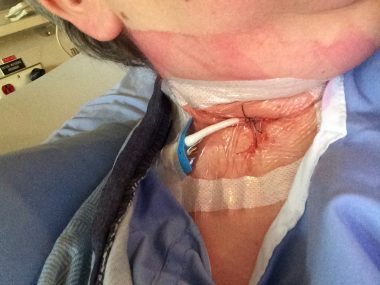In the Blink of an Eye, My Vision Was Threatened
Written by |

When I was misdiagnosed with multiple sclerosis (MS), and five years later, properly diagnosed with neuromyelitis optica (NMO), I was told that a hallmark symptom of each disease was optic neuritis. This occurs when the immune system mistakenly attacks the optic nerve, causing inflammation, which can lead to blindness.
I’ve had NMO since I was 12 years old, but didn’t have an optic neuritis attack until I was 41. Ironically, experiencing five attacks within six months in 2012 was the catalyst to being diagnosed with NMO.
The change in my vision crept up on me. When I first became aware that my vision wasn’t normal, it felt like there was a film over my eyes. I kept thinking that if I could just blink hard enough, it would clear, but it didn’t.
Sometimes the backs of my eyes would hurt. It felt as if my eyes were being pulled out of their sockets. When I’d look from side to side, it felt like there was grit or sand in my eyes, because the movement wasn’t smooth, and any movement was painful. Periodically, I’d have blurred or double vision, or my vision would dim, as if I’d walked into a dark room from outside and my eyes hadn’t adjusted to the change in light.
My final optic neuritis attack that year was pretty dramatic. I caught a bus one day to go to a meeting five minutes away from home. When I boarded the bus, I was perfectly fine. When I got off the bus, I couldn’t see. It was as if someone had smeared Vaseline over my eyes. I sat through the meeting, quietly freaking out before calling my husband to come rescue me. In a panic, I called my neurologist for help.
After I was diagnosed with NMO, I managed to avoid further optic neuritis attacks for six years, until my preventive therapy failed me. I had my most serious NMO attack in February 2018. My eyes started hurting, and I knew I was in trouble.
My neuro-ophthalmologist ordered three days of outpatient IV steroid treatments, with the warning that if it hadn’t resolved after three days, I was to go directly to the emergency room and be admitted for further treatment. The IV steroids weren’t enough. I was still in tremendous pain, and my vision hadn’t recovered, so I went to the only hospital in the city that could treat me using plasma exchange (PLEX).

While hospitalized, I was hooked up to this machine, which provides plasma exchange treatment. (Photo by Lelainia Lloyd)
PLEX is a treatment used to reduce the level of inflammatory antibodies in the blood. I had a catheter surgically placed in the carotid artery in the neck, though other veins may be used. The catheter has two ends called lumen. One lumen is then hooked up to a machine that filters the blood, and the other is hooked up to bottles of artificial plasma, which replace the plasma being filtered out of the blood by the machine. (The body can’t replace the plasma fast enough on its own.)
My PLEX procedures lasted four hours, and were administered every other day for a total of five treatments. Once I was hooked up to the machine, I couldn’t get out of bed, not even to use the washroom. It made for a very long, grueling treatment.

This catheter implanted in my neck facilitated the plasma exchange. (Photo by Lelainia Lloyd)
The implant of the catheter was done under a local anesthetic, and unfortunately, the first time providers went to hook me up for treatment, it failed to work. This meant another trip back to the operating room to pull the faulty line and replace it. This was no small thing, and my incision hurt the entire 12 days I was in the hospital. I had to have an ice pack on the incision round-the-clock.
Once my five treatments were complete, the hematologist who was looking after me came to remove my catheter. This was a scary experience. My providers explained that once they pulled it out, I would have to lie absolutely still for 15 minutes while they held pressure on my neck to allow my blood to clot. Otherwise, I could bleed out, which would be fatal. It was the longest 15 minutes of my life! Fortunately, my hematologist could tell I was scared and reassured me the entire time.
After 12 days in the hospital, I was so relieved to be able to go home. I had a pretty good scar on my neck for about a year, but it healed. I was incredibly lucky that my vision also healed because I had recognized the symptoms of optic neuritis and knew the importance of seeking treatment immediately.
I hope I never have an attack like that again.
***
Note: Neuromyelitis News is strictly a news and information website about the disease. It does not provide medical advice, diagnosis, or treatment. This content is not intended to be a substitute for professional medical advice, diagnosis, or treatment. Always seek the advice of your physician or other qualified health providers with any questions you may have regarding a medical condition. Never disregard professional medical advice or delay in seeking it because of something you have read on this website. The opinions expressed in this column are not those of Neuromyelitis News, or its parent company, Bionews, and are intended to spark discussion about issues pertaining to neuromyelitis optica spectrum disorder (NMOSD).







Leave a comment
Fill in the required fields to post. Your email address will not be published.